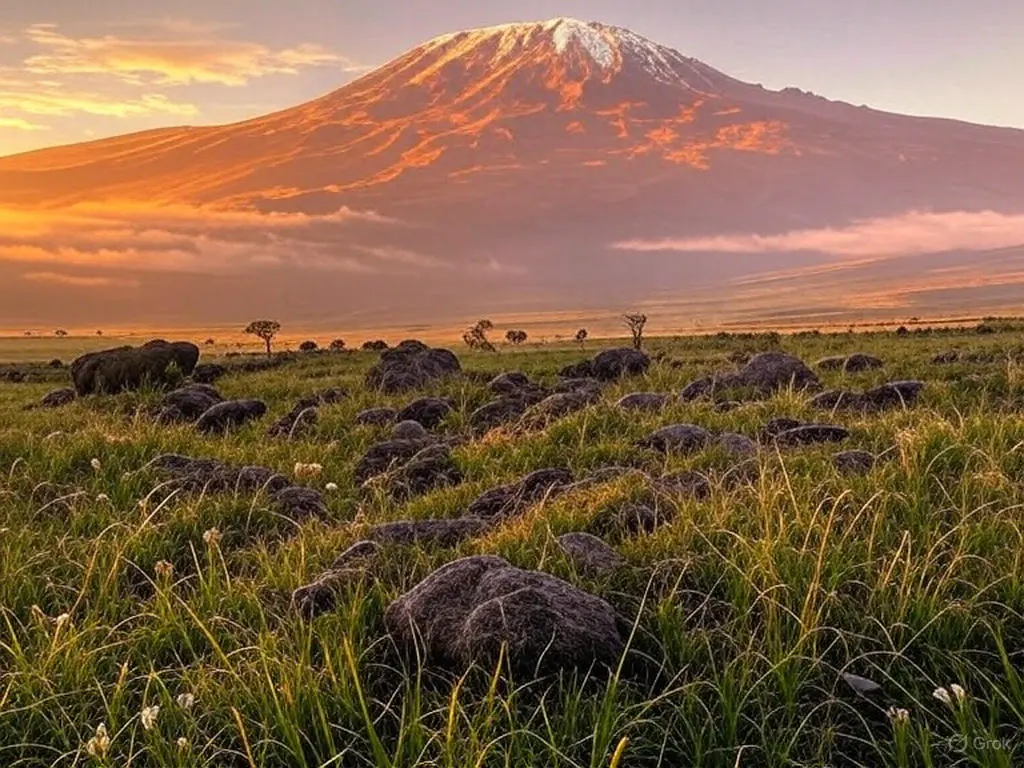Mount Kilimanjaro is one of the most famous mountains in the world. It is the highest mountain in Africa, standing tall at 5,895 meters (19,341 feet). Located in Tanzania, this iconic peak attracts thousands of climbers and adventure seekers every year. But Kilimanjaro is more than just a climbing spot—it’s a place full of history, mystery, and natural beauty.
What Are Some Interesting Facts About Kilimanjaro?
Mount Kilimanjaro is Africa’s highest peak and the tallest free-standing mountain in the world. It features three volcanic cones—Kibo, Mawenzi, and Shira—and spans five distinct climate zones, from rainforest to arctic. Despite being near the equator, its summit is capped with glaciers. These Kilimanjaro facts highlight its unique geology, ecological diversity, and global mountaineering appeal.
What Makes Kilimanjaro Unique?
What makes Mount Kilimanjaro unique is that it’s a free-standing mountain, not part of any mountain range. In fact, one of the most interesting facts about Kilimanjaro is that it is actually a volcano. Don’t worry—it’s no longer active. Scientists believe it formed millions of years ago through volcanic eruptions. Today, it features three volcanic cones: Kibo, Mawenzi, and Shira. Kibo, the tallest, is covered with glaciers and snow, even though Kilimanjaro is near the equator.
Adding to its uniqueness, Kilimanjaro offers trekkers the chance to journey through vastly different ecological zones in a matter of days, making it one of the few places on Earth where such a dramatic transition is possible without crossing continents.
Facts About the Height and Structure of the Kilimanjaro
- Highest Mountain in Africa: At 5,895 meters, Mount Kilimanjaro is the tallest peak on the African continent. Its summit, Uhuru Peak, is known as the “Roof of Africa.”
- Tallest Free-Standing Mountain: Unlike many mountains that are part of ranges, Kilimanjaro stands alone. This is one of the most remarkable Kilimanjaro facts.
The Volcanic Cones: Kibo, Mawenzi, and Shira
Mount Kilimanjaro consists of three volcanic cones:
- Kibo (5,895 meters): The central and highest cone.
- Mawenzi (5,149 meters): Rugged and deeply eroded.
- Shira (4,005 meters): Mostly eroded into a plateau.
One of the interesting facts about Kilimanjaro is that while Shira and Mawenzi are extinct, Kibo is dormant and could erupt again in the distant future.
A Glimpse into Kilimanjaro’s History
The first recorded ascent of Mount Kilimanjaro took place on October 6, 1889. German geologist Hans Meyer, Austrian mountaineer Ludwig Purtscheller, and local guide Yohani Kinyala Lauwo completed this pioneering climb. Their successful summit opened the door for modern-day trekking.
Before Meyer’s expedition, Kilimanjaro held cultural significance for local tribes such as the Chagga, who believed the mountain was home to spiritual forces. Their traditions and myths surrounding Kilimanjaro are still respected today.
Exploring the Mountain’s Climate Zones
Climbers experience five distinct climate zones during the ascent:
- Cultivation Zone (800–1,800 meters)
- Rainforest Zone (1,800–2,800 meters)
- Heather-Moorland Zone (2,800–4,000 meters)
- Alpine Desert Zone (4,000–5,000 meters)
- Arctic Zone (Above 5,000 meters)
This vertical transition offers some of the most fascinating facts about Kilimanjaro. Each zone hosts different ecosystems, from lush tropical forests to barren, icy landscapes.
Why Climbers from Around the World Are Drawn to Kilimanjaro
Mount Kilimanjaro is part of the Seven Summits—the highest mountains on each continent. It ranks fourth in height but is considered one of the most achievable peaks, especially for non-technical climbers. These facts about Kilimanjaro make it a dream for many adventurers.
It also appeals to those seeking a personal challenge, offering a mental and physical test while requiring no ropes or ice axes. Its relative accessibility makes it a bucket-list destination.
Climate Concerns and Shrinking Glaciers
One of the most concerning Kilimanjaro facts is the rapid loss of its glaciers. Scientists estimate an 85% decrease in ice cover between 1912 and 2011. These disappearing glaciers highlight the impact of global warming on high-altitude ecosystems.
Conservation groups and scientists are studying Kilimanjaro closely, hoping to preserve its ecological balance. Efforts include reforestation projects on the lower slopes and better waste management along trekking routes.
Trekking Without Technical Skills
Unlike many high mountains, no technical climbing gear is needed for Kilimanjaro. This makes it ideal for trekkers who are physically fit but have limited mountaineering experience.
Still, the climb is not without risks. Altitude sickness is common, and success depends on acclimatization and proper preparation.
Kilimanjaro’s Popularity and Accessibility
Approximately 30,000 to 50,000 people climb Kilimanjaro each year. Routes like Marangu, Machame, and Lemosho cater to different fitness levels and preferences. One of the facts about Kilimanjaro that boosts its popularity is that it’s accessible to first-time climbers.
Guided treks are required to protect the environment and ensure safety, providing income to local guides and porters who form the backbone of Kilimanjaro’s tourism industry.
Kilimanjaro’s Influence on Literature and Culture
Mount Kilimanjaro has inspired numerous works of art and literature. Ernest Hemingway’s “The Snows of Kilimanjaro” is one of the most notable examples, using the mountain as a metaphor for adventure and the passage of time.
The mountain also features in local folklore. For example, some Chagga legends describe Kibo as the seat of the gods, reinforcing the mountain’s spiritual status in East African culture.
Flora and Fauna on the Slopes
Despite its altitude, Kilimanjaro is home to a variety of unique flora and fauna:
- Lower rainforest zones host monkeys, birds, and small mammals.
- Higher zones support specialized plants like giant lobelias.
- Endemic species, such as the Kilimanjaro tree hyrax and unique butterflies, can be found in isolated pockets.
This biodiversity adds to the amazing facts about Kilimanjaro.
The Meaning Behind the Name “Kilimanjaro”
The origin of the name “Kilimanjaro” is still debated. Possible roots include the Swahili word kilima (mountain) and njaro (whiteness or shining). Different ethnic groups have used various names, making this one of the more mysterious Kilimanjaro facts.
In Maasai, the mountain is referred to as “Ol Doinyo Oibor,” meaning “White Mountain.” This variety of interpretations underscores the mountain’s cultural richness.
Protected by Kilimanjaro National Park
Mount Kilimanjaro is located within Kilimanjaro National Park, a protected area established in 1973 and designated as a UNESCO World Heritage Site in 1987. Managed by TANAPA, the park conserves the mountain’s ecology and supports sustainable tourism.
Rangers, conservationists, and local communities collaborate to balance tourism with environmental protection, ensuring the mountain’s legacy endures.
Kilimanjaro Facts: Rapid Weather Changes
As you climb Kilimanjaro, you’ll experience tropical, temperate, and arctic climates in just a few days. This variety of weather conditions is one of the most compelling facts about Kilimanjaro.
Sudden changes in weather can catch climbers off guard, so preparation for all conditions is essential.
Record-Breaking Achievements on the Peak
Mount Kilimanjaro has been the stage for numerous world records:
- Fastest ascent and descent: 6 hours 42 minutes by Karl Egloff.
- Youngest climber: Keats Boyd, age 7.
- Oldest climber: Anne Lorimor, age 89.
Other notable achievements include charity climbs, adaptive climbs by people with disabilities, and even weddings held at the summit.
These Kilimanjaro facts demonstrate how the mountain appeals to climbers of all ages and backgrounds.
Final Thoughts: What We Can Learn from Kilimanjaro
Climbing Mount Kilimanjaro is more than a physical challenge. It’s a journey through ecosystems, cultures, and time. Whether you’re planning a trek or simply fascinated by its history and geography, these facts about Kilimanjaro will deepen your appreciation for one of Earth’s most iconic peaks.
Understanding Kilimanjaro’s cultural legacy, ecological importance, and changing climate reminds us of our shared responsibility to protect this natural wonder for generations to come.




